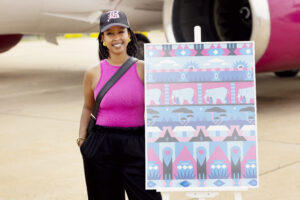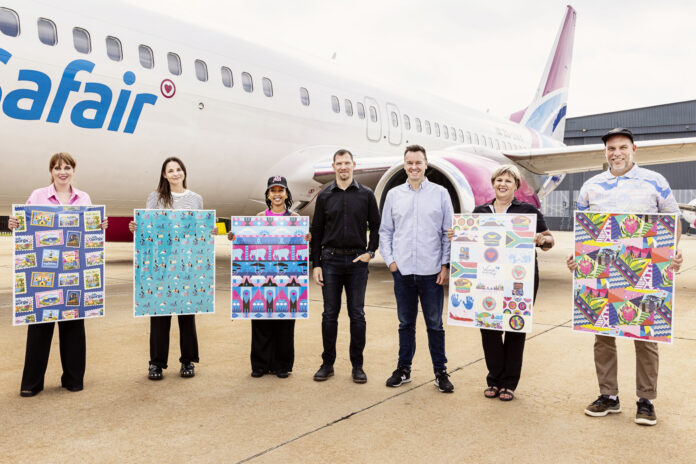Johannesburg – FlySafair has launched the second of their art campaigns, a project in which local artists are commissioned to create specifically South African designs that will be placed on the interior of seven of the airlines Boeing 737’s. Although the campaign may seem simple on the surface, the application of interior décor to an aircraft involves significant technical and logistical hurdles which must be overcome before this project could take flight.

Colour counts
Generally speaking, the livery of most commercial aircraft is predominantly white. However, this is far from an aesthetic choice. There are a number of benefits to having a predominantly white livery. While factors like reduced cabin heating, lowered chance of bird strikes, and easier spotting of damage are definite motivators, interestingly weight also plays a role. Depending on the colours used, the livery of an aircraft can add an additional 272-544 kgs of weight to an aircraft. The reason for this is the additional weight which pigments add. White paint does not contain as many pigments and so is lighter. This is important as a standard Boeing 737-800 will take up to four layers of paint at around 190kg per layer. This means that while colourful designs may be aesthetically pleasing, the impact on fuel efficiency and air speed are significant.
Thankfully, the same rules do not apply to the interior.
“Most aircraft are delivered with white and blue interiors,” said Kirby Gordon, Chief Marketing Officer at FlySafair. “According to Boeing, this is because of the calming effect of the colours as well as blue’s ability to depict competence, dependability, and intelligence.”
To conduct these upgrades to the interior, FlySafair have had the designs printed on Aviation approved specialised calendered vinyl. The material comes in a standard gloss white and can be printed on using specialised inkjet methods. This allows the airline to add additional colour to their aircraft without contributing to the overall weight in the same way exterior modifications would.
Regulatory Requirements
Deciding on what materials to use for a project like this is also laced with complexity. There are a number of regulatory requirements which materials must meet before installation. Chief among these is FAR 25.853* which was introduced in the late 1980s and speaks to flammability requirements for aircraft over 12,500kg.
“The interior of commercial aircraft is highly complex and rapidly evolving as new technologies are introduced,” said Gordon. “As with almost all aspects of aviation, the interior of an aircraft is subject to significant regulation. Every aspect of the prints needs to tested. The vinyl base, for example, which includes a specialised adhesive is applied to an aluminum base and subjected to a flame for 15 seconds. To pass, the film needs to stop burning within 15 seconds of the flame being removed.”
Similarly, each ink colour needs to be tested to ensure they also meet flammability and toxicity standards.
“Luckily, with the advancement of materials and printing options, the possibilities for creating new designs are endless,” said Gordon.
Placement Matters
The second of the regulatory requirements is that emergency equipment needs to remain clearly visible. Many of the designs produced for this project are rich in colour and detail. Although beautiful to look at, these busy visuals have the potential to obscure important emergency equipment.
“We had to be strategic when deciding where to place these designs. Our goal was to place them in areas where the customers could enjoy them throughout the flight without infringing on areas which house emergency equipment,” said Gordon.
At the moment the designs will sit on the forward galley and the aft forward-facing wall of the lavatory cubicles, giving customers the best view without interrupting safety protocols.
Shifting Schedules
In addition to regulatory concerns, scheduling is another of the biggest challenges faced by airlines when conducting upgrades of any sort. It can take approximately one to two weeks for a team of 20 specialists to paint the exterior of an aircraft. Depending on the job, interior modifications take a similar length of time. For an airline, pulling several aircraft from the schedule at one time can be disastrous, even during quiet periods.
“While we would love to have all the artwork up and flying at the same time, having seven aircraft from our fleet non-operational at one time would cause major issues in terms of capacity and frequency on our routes. To ensure operations continue as usual, we wait for each aircraft to come in for their routine heavy maintenance. This gives us enough time to complete these visual upgrades without disrupting the schedule,” concluded Gordon
To date, the upgrades to two aircraft have been completed, with another scheduled to enter the maintenance hangar soon. Keep an eye out for the designs, which is not only a testament to the artists’ creativity but also technological advancements which have made unique interiors both possible and safe.
About Flysafair
FlySafair, Southern Africa’s leading low-cost carrier and proud Trusted Domestic Carrier for the Springboks, offers budget-friendly flights starting at R550* for domestic travel between nine destinations. This now includes Cape Town to Mbombela, starting at just R1851*. FlySafair also operates six international routes, connecting South Africa with our African neighbours starting from R1,400*. Since beginning operations began in 2014, the airline has been ranked the top on-time low-cost airline in the world by Cirium. In 2023, FlySafair received five awards at the Civil Aviation Industry Awards, including Best Airline Operator/Airline, Aviation Maintenance Organisation Award: Medium – Large, and Aviation Professional presented to CEO Elmar Conradie. The airline also earned the Best Airline Award as voted by the public and the Skytrax Best Low-Cost Airline in Africa award in 2021, 2022, and 2023.

